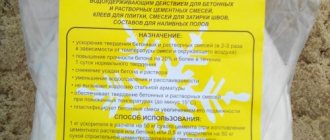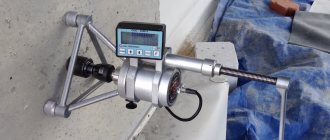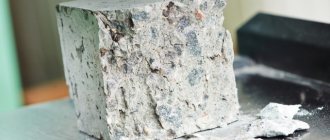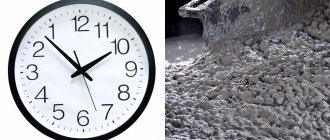- 1 Set-up process 1.1 Setting
- 1.2 Hardening
The main characteristic of concrete, which determined its widespread use, is its high strength. The material gains any strength in real conditions, since there are many reasons that contribute to the shortage of the value corresponding to concrete of a certain grade. Knowledge of these reasons and their characteristics contributes to the formation of concrete foundations and structures with maximum performance indicators.
Recruitment process
Physico-chemical hydration reactions create new monolithic compounds that give the material the properties of artificial stone. The new quality is formed over many days (finally after about six months) and ideally the strength properties of a concrete structure should correspond to concrete of a certain class and grade. In terms of time, the process of stone ripening has two successive stages: the initial stage - setting, and the final stage - hardening. Once completed, the concrete can be loaded.
Return to contents
Grasping
Scheme of possible stratification of the concrete mixture: a - during transportation and compaction, b - after compaction;
1 - direction in which water is squeezed out, 2 - water, 3, 4 - fine and coarse aggregates. Concrete is not used immediately after hardening, as it may take some time to transport the material to the site. The mixture should remain mobile, which is facilitated by mechanical stirring of the solution in the mixer of the automixer. Thixotropy allows you to preserve the basic properties of the mixture before it is poured, delaying the start of the initial stage of maturation. However, you should know that if time is delayed or the temperature rises, an irreversible process of “welding” of the solution develops, as a result of which its characteristics are reduced.
The setting time depends on the air temperature - from 20 minutes. until 20 o'clock. The longest duration of this process is in winter at temperatures around 0 degrees. Pouring the foundation during this period will be accompanied by an extension of the initial setting interval from 6 to 10 hours, and the stage itself will extend for 15 to 20 hours.
It is optimal to pour concrete into the mold at 20 degrees. Then, provided that the solution is mixed an hour before pouring, setting will begin after one hour and complete after 60 minutes. Hot weather contributes to the almost instant setting of the solution in 10 - 20 minutes.
Return to contents
Hardening
The optimal course of hydration during hardening of the solution: temperature range from 18 to 20 degrees, humidity close to 100%. Deviations from these parameters significantly change the hardening rate of the stone. Complete maturation of concrete takes several years.
At the same time, at this stage the hardening rate naturally changes with time. For example, for M300 concrete, by the end of the 3rd day it reaches 50%, on the 14th day it reaches 90%, and on the 28th day - 100%. Then, after three months, the strength increases by another 20%, and after 3 years it can become 100% greater than it was by the end of 28 days after mixing.
Return to contents
When to accelerate hardening
The processes of setting and strengthening require acceleration:
If necessary, carry out construction work in winter to reduce the cost of heating the concrete.
When early stripping is needed.
If necessary, continue construction earlier than after 28 days.
For the production of a large number of small concrete products (production of paving stones, paving slabs).
To optimize strength.
Strengthening Features
A decrease in the temperature of the environment leads to a slowdown in hardening. The zero mark on the thermometer stops the process due to the freezing of water in the stone (the quality of the concrete decreases), and a rise in values resumes it again. The mixture begins to dry out when there is little or no moisture, but this can slow down and stop proper curing, which will prevent the concrete from gaining the desired properties. But autoclave hardening of mixtures is significantly accelerated at elevated temperatures and humidity conditions: 80 – 90 degrees. and 100% humidity, which leads to an accelerated increase in strength indicators. Due to moisture in the air, the strength-building interval of a mortar that is laid openly may be shortened.
Concrete of higher grades (consisting of more cement of better quality) hardens and gains strength faster, so they should be processed more quickly. In the interval from the 3rd to the 10th day after laying, the standard strength gain of concrete is ensured by curing conditions close to ideal. In warm weather, the solution is covered with moisture-absorbing materials, through which the stone is moistened around the clock 6 - 7 times, and covered with a dense film.
In sunny weather it is protected from direct rays. In winter, concrete can be artificially heated from the inside, insulated, heated by heat generators to prevent water from freezing, and insulated from precipitation. An important parameter for the continuation of work is the regulatory and safe period for the development of strength properties. Table 1 shows the dependence of the strength indicators of concrete on the brand of concrete and the average daily temperature after the corresponding number of days.
Table 1
The standard safe period for concrete maturation can be considered 50%, and safe - from 72% to 80% of the brand value, which, for example, is important to know when working on the foundation.
Return to contents
Resistance of concrete to external influences
Concrete corrosion
Concrete corrosion (destruction of cement stone) occurs due to many factors:
- environmental influences,
- mechanical influences,
- water penetration,
- temperature changes (freezing/thawing, heating/sharp cooling).
Violation of the structure of cement stone is accompanied by a decrease in its adhesion to reinforcing elements, an increase in water permeability and, as a result, a decrease in strength. To increase the corrosion resistance of concrete, the following measures are recommended:
- use of special acid-resistant, aluminous or pozzolanic cements;
- introduction of water-repellent, heat-resistant or frost-resistant additives into mixtures;
- increasing the density of concrete. The durability of concrete, in addition to the composition of the mixture and the ratio of components, is greatly influenced by the technology of preparation and delivery, laying and subsequent maintenance. Vibratory mixing of the mixture increases the activity of cement and makes it possible to obtain dough with a macrohomogeneous structure, and transportation in mixers avoids its separation when delivered to the site. The effect of vibration compaction when laying dough is explained by the displacement of air bubbles: in an uncompacted mixture it can reach 45%. Removing air protects concrete from corrosion, increases strength, frost and heat resistance, and also reduces the water permeability of concrete.
What does strength gain depend on?
Factors that control the set of strength properties of stone include: how much time has passed after pouring, temperature and humidity conditions, quality (activity) and grade of cement, ratio of water and cement in the solution, proportions of components in the mixture, method of compaction, mixing technology, method and the speed of laying, the quality and regularity of moisture, the presence of plasticizers (hardening accelerator additives) in the mixture in winter, etc. Raising the grade of concrete depends on an increase in the proportion and higher grade of cement in the mixture, the proportions of the components. The brand directly affects the strength gain of concrete. For low grades, critical strength is more important. Table 2 reflects this pattern.
table 2
Therefore, the strength of a high-grade concrete foundation determines the reliability and durability of the building structure. In cold weather, stone gains strength due to its own heat generation, but to normalize the stone formation schedule, it is advisable to use appropriate additives that accelerate hardening and reduce the temperature at which hydration stops. With them, the mixture gains brand strength after 14 days. A good solution would also be to change the components in concrete. For example, aluminous cement gains strength even in cold weather, as it releases approximately 7 times more of its own heat compared to Portland cement.
The shape and grain fraction of natural fillers play a significant role in achieving this property. Their irregular shape and increased roughness provide better adhesion conditions and quality of concrete. It is known that an increase in the proportion of water in a concrete mixture can lead to separation of the mass of material. The consequence of this is also that with a relative increase in the proportion of water in the solution by 60% of the optimal value (w/c = 0.4), a decrease in strength by 50% of the brand value occurs. However, with a water/cement ratio of 1/4, the curing (hardening) period is halved.
To speed up the process and minimize the curing of concrete, it is advisable to use sand concrete with a low water/cement ratio. An uncompacted concrete solution has a chance to mature only to 50% of the standard strength, even with an optimal water/cement ratio. At the same time, manual compaction can increase its strength by 30 - 40%, and vibrating rammer increases the strength to the standard 95 - 100%.
Return to contents
Methods for accelerating concrete hardening
Sometimes it is necessary to speed up the curing process of the foundation. For example, in winter or according to the requirements of construction technology. To speed up the hardening process, 2 methods are used:
- Warming up the mixture with heat guns and other heating elements installed in the general body of the foundation. Increasing the temperature by 10° C accelerates the set of hardness by 2 - 4 times. It should be remembered that the final temperature should not exceed +90° C. The disadvantages of the method are high energy costs and, accordingly, material costs.
- Use of chemical plasticizers. These substances help accelerate the setting of the mixture and its hardening. Complex foundation additives are also common. They are much more effective than single ones.
The graph shows the curing time of concrete in days with and without additives.
Strengthening schedule
It is important to know the concrete strength development schedule to predict the consequences of changing temperature curing conditions, which lead to an increase in curing time.
Schedule 1
Graph 1 shows, using M400 concrete as an example, how many days it takes for the mixture at fixed temperature values to gain a certain percentage of strength (one hundred percent is taken to be the gain of brand strength in 4 weeks). Temperature 30 degrees. is optimal for gaining standard strength (97%) in 11 days, and with an indicator of 5 degrees. The safe strength value will not be reached by the stone even in 14 days. In such a situation, you should warm up and insulate the styling. In accordance with the curves, the timing of stripping is determined when the strength exceeds 50% of the brand value.
Return to contents
Components of concrete mortar for foundation
The concrete solution is mixed from proportionally added bulk substances and water. It consists of a mixture of binder (Portland cement), gravel or crushed stone (fillers), purified or river sand. The dry mixture is mixed with water. When the ratios of components change, the grade of concrete for the foundation also changes. The determination of the grade is also influenced by the setting conditions of the solution, for example, the street temperature, which should be equal to ≈ +20 0 C. When the temperature deviates in one direction or another, the grade strength decreases.
Concrete gains its design strength in 28 days, and concrete gains up to half its strength in the first 5-7 days. Thus, without waiting for full strength to be achieved, you can begin further construction work within a week. With the correct composition of concrete, strength increases throughout the entire service life of the concrete structure. But the basis for brand strength is its value for the first four weeks.
Concrete strength chart
| Concrete grade by compressive strength | Critical strength of concrete (% of brand strength) |
| M 15-M 150 | ≥ 50% |
| M 200-M 300 | ≥ 40% |
| M 400-M 400 | ≥ 30% |
| For prestressed structures | ≥ 70% |











